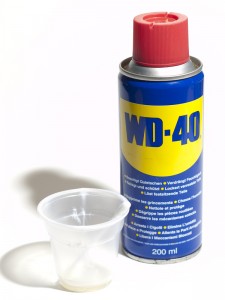Sticky door locks can be quite frustrating and inconvenient, especially during the colder months, when the last thing you want to happen after a long day at work is to find yourself locked out in the cold, struggling to get back into your home.
In some cases, it’s not really the door lock that’s stuck, but rather the door has shifted in the frame, or expanded because of dampness. If the key fits in the lock and rotates easily, then it’s the door that’s stuck. However, if the lock won’t rotate then you can be confident that it’s the locking mechanism itself which is stuck. The good news is that fixing a sticky locking mechanism is a fairly simple DIY project, and you don’t have to spend a lot of time or money to make your lock feel like new once again.
It’s important to note that locks should not be stubborn. It is normal for locks to start to stick occasionally after repeated use, but they should not seize up frequently. Lubricating a lock every couple of months is simply putting a band-aid on a more serious problem. If your lock sticks on a regular basis, get it changed.
Tools Needed
- Powdered Graphite
- Safety glasses
- A fine metal file
Image source: http://www.flickr.com/photos/chrisinplymouth/4953773521/
hhh
Time Required
Fixing a sticky lock takes just a few minutes.
Step by Step Instructions
1. Take a tube of powdered graphite, and carefully cut the tip off the tube.
2. Insert the tip of the tube into the keyhole, and gently squeeze the tube to release a couple of drops of graphite. Do not squeeze too hard, only a tiny amount of graphite is needed to get the lock moving again. Take care not to breathe in any graphite particles while you are doing this.
3. Inspect your key. If the key looks clean and smooth, proceed the the next step. If it is dirty or has visible burrs on it, gently file the edges of the key smooth (taking care not to deform the teeth on the key).
4. Insert your key into the lock and wiggle it back and forth to move the graphite around it.
5. Add a little graphite lubricant to the latch of the door as well. Carefully replace the lid on the graphite, taking care not to spill any. Graphite dust is difficult to get out of clothes.
6. If you have a door with a handle or a deadlock, remove the handle (or lock) to squirt in the graphite. Working with deadlocks is a little more complicated than working with standard locks. If you aren’t confident in your ability to do the job correctly, call in a locksmith.
6. Turn the key, you should find that it moves smoothly.
Some Additional Tips
Some people swear by using general purpose lubricants to fix sticking locks. This may be OK as an emergency measure, but it is not a good idea in the long term. Spraying sewing machine oil, WD-40, or, worse, vegetable oil, into your lock will make it move for a little while, but in the long run it will cause more problems than it solves.
Image source: wd40 http://www.flickr.com/photos/e-coli/5142145393/
hhhhh
The oil or grease contained in those general purpose lubricants will attract dust and dirt, and form a layer of grime inside the lock. This will make the lock seize up again, and eventually leave you with a lock that is completely stuck. Do not waste your time with these home remedies. Graphite is a much safer lubricant to use on a stuck lock.
If you’re stuck outside your property and you don’t have access to a tube of graphite, don’t despair. You can achieve similar results using a graphite pencil. Rub the pencil all over the edges of your key, so that the teeth of the key are thoroughly covered in graphite, then put the key into the lock. If you’re lucky, that will offer enough lubrication to open the door. If that doesn’t work then you may need to ask a neighbour for some lubricant. There’s a high chance that someone in the area will have some WD-40 in their tool box.
If you’ve tried lots of different lubricants and you still cannot get the door open, then the problem may be with the key, not the lock. Get a new key cut, and see if that solves the issue. If you still have problems with the new key, this means that the lock is defective and you should get the entire lock replaced.
If you find that the key turns in the door, but the door is still difficult to open, then the latch may be catching on the strike plate. This is a separate issue, and fixing it is deserving of its own how-to guide. In brief, you can fix this issue by moving the strike plate so that it lines up better with the latch.
Conclusion
Keep the graphite on hand, just in case you encounter more problems with your lock. It is normal for locks to seize up occasionally, but if you find that you are needing to un-stick your door fairly frequently, consider investing in a new lock.
Even graphite can build up in your lock and cause problems in the long term. some locksmiths prefer liquid lubricants such as Lockshot or LPS-1, which are designed specifically for use in doors. Whatever lubricant you use, be sure to apply it sparingly.
Sticking locks can be a frustrating problem, especially if they happen when no-one else is at home to let you in. It is a good idea to inspect your door before winter hits, and make sure that the hinges are well lubricated, the strike plate lines up properly and the door lines up well with the frame. Keep your keys clean to prevent dirt and grime from accumulating in the lock. Lubricate your lock, sparingly, when necessary and you should not have any problems.







